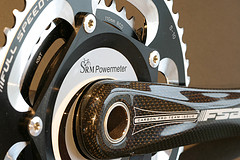My Goals as Cycling Coach 2008
I thought it might be interesting to have a little insight look to my work as cycling coach in 2008.
This season I have significantly reduced the number of riders I plan training for. Thus, I have only 2 riders that receive training plans in 2008. These two riders are both very talented and focused on optimizing their training with power meters, so I still spend quite a lot time on coaching. The most important reason I have reduced the number of athletes is time. July 2007 I became dad for the very first time and in January 2008 I finally graduated as medical doctor at the University of Aarhus.
Becoming dad was the most fantastic experience ever and makes every day even better. Thus, I have naturally given the highest priority to my little daughter, Lea. Finishing of my studies on the university also took a lot time and starting in my first job as medical doctor is obviously also quite time consuming. These two factors made me conclude that I had to reduce the number of athletes if I shouldn’t reduce the quality of what I did.
As I mentioned previously, I will only be coaching two riders this year.
U23 rider makes progress with SRM power meter
The first rider is Jakob Bering who is riding his second season as U23 rider. He rides for a continental team called Team Designa Køkken. I have been coaching him for more than 6 years. He won a silver medal at the national championships for U23 last season and played a central role in Denmark’s team victory in Tour de l’Avenir (Tour de France for U23). He is a climber and is currently training very hard to peak his performance in a stage race in April. Hopefully he will be representing Denmark in the U23 World Championships later this year.
Jakob uses a SRM power meter in all intervals and until now I have been very satisfied with the numbers I receive in my inbox. He is stronger than last year and compared to last season we’ve known the dates for peak performance in months. There is a huge difference from planning a peak performance in two months instead of just two weeks (or less..!). Now he is a more integrated part of the national team, which gives me a better possibility to plan his training and tapering compared to last year where every little stage race was like having an exam. When I plan a tapering protocol for a specific race I usually start at the peaking moment and work backwards. If I have 14 days, I start with the day before the big event, then the day before that one and so on until I reach day 1 in the program.
Tapering protocol is a corner stone
Thus, my programs are often identical in the final period because the tapering protocol is a corner stone in all my training programs. Though these tapering protocols look identical they might be adjusted to some specific requirements in the upcoming event.
Junior rider focusing on climbing
My other rider is Rasmus Malmkjær who is a talented junior rider. He rides on a very strong junior team which is probably the strongest junior team in Europe (Team Festina Hobro). His speciality is climbing steep climbs, so I hope that he will make some good results in some international junior races in southern Europe this year. He uses a Polar CS600 to optimize his results. Climbing is his number one skill, but on home ground in Denmark he will still be a strong rider, though he will be not strong enough to compete with the best riders on windy, flat roads. My biggest challenge is to make him produce as many watts as possible compared to body weight, making him an even better climber. We won’t focus much on flat races, because that will never be his speciality.
Challenging jobs as cycling coach in 2008
Thus, I have some really challenging and exciting jobs as cycling coach this year even though I have significantly fewer riders. I have received several emails with questions about why I’m not posting so often and I hope that this post explain why. Since July 2008 I have re-published some articles that deserved some additional attention. I hope that all readers understand and in some way respect this decision.
What coaching jobs I will do in 2009 is still uncertain.
If you have any questions or comments to my plans for 2008, feel free to post a comment.
My Goals as Cycling Coach 2008 Read More »


